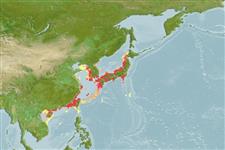Teleostei (teleosts) >
Beloniformes (Needle fishes) >
Hemiramphidae (Halfbeaks)
Etymology: Hyporhamphus: Greek, hypo = under + Greek, rhamphos = beak, bill (Ref. 45335).
Eponymy: Benoit Gernart (ca: 1797–1843) was French Consul-General in China based in Canton (1827–1837), and later in West Java and at Macao where he obtained the halfbeak. (Ref. 128868), visit book page.
More on author: Valenciennes.
Environment: milieu / climate zone / depth range / distribution range
Ecology
Marine; pelagic-neritic; depth range 0 - ? m. Subtropical
Northwest Pacific: restricted to the temperate zone in coastal waters of continental China (from Peitaho in Liaotung Bay to Hong Kong), Taiwan, and Korea (Fusan).
Length at first maturity / Size / Weight / Age
Maturity: Lm ?, range 13 - ? cm
Max length : 16.1 cm SL male/unsexed; (Ref. 10943)
Short description
Identification keys | Morphology | Morphometrics
Dorsal spines (total): 0; Dorsal soft rays (total): 13 - 15; Anal spines: 0; Anal soft rays: 14 - 17; Vertebrae: 51 - 53. Long recurved unicuspid teeth arranged in only 1-2 rows in the anterior parts of both jaws. Predorsal scales 35-40; pelvic fins located closer to the origin of the pectoral fin so that the P2-C distance extended forward reaches the orbit. Lower jaw about equal to head length.
A coastal water species.
Life cycle and mating behavior
Maturity | Reproduction | Spawning | Eggs | Fecundity | Larvae
Collette, B.B. and J. Su, 1986. The halfbeaks (Pisces, Beloniformes, Hemiramphidae) of the Far East. Proc. Acad. Nat. Sci. Philadelphia 138(1):250-301. (Ref. 10943)
IUCN Red List Status (Ref. 130435: Version 2024-2)
Threat to humans
Harmless
Human uses
Tools
Special reports
Download XML
Internet sources
Estimates based on models
Phylogenetic diversity index (Ref.
82804): PD
50 = 0.5000 [Uniqueness, from 0.5 = low to 2.0 = high].
Bayesian length-weight: a=0.00257 (0.00115 - 0.00574), b=3.09 (2.91 - 3.27), in cm total length, based on LWR estimates for this Genus-body shape (Ref.
93245).
Trophic level (Ref.
69278): 3.0 ±0.4 se; based on size and trophs of closest relatives
Resilience (Ref.
120179): High, minimum population doubling time less than 15 months (Preliminary K or Fecundity.).
Fishing Vulnerability (Ref.
59153): Low vulnerability (10 of 100).
